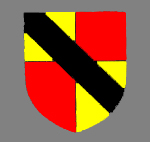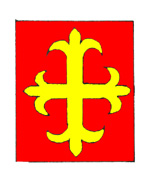The Manor of Grymsbury Bolnhurst

The Barony of Bedford
Volume III of The Victoria County History for Bedfordshirepublished in 1912 gives details of the manors in Bolnhurst. The Manor of Grymsbury seems to have its genesis in land held by the Bishop of Coutances as recorded by the Domesday Book of 1086. When the bishop died the manor reverted to the Crown and was then granted to the Barony of Bedford.

Latimer arms
From at least 1190 to at least 1303 the Lenveise family were intermediary lords of the manor beneath the Barony as overlord. John de Beauchamp, Baron of Bedford, was killed fighting for Simon de Montfort against King Henry III (1216-1272) at the Battle of Evesham in 1265. His possessions, including the overlordship Manor of Grymsbury, were to be divided between his heirs, his three sisters. Beatrice, the youngest sister, married Thomas Fitz Otho who died in 1274 when she married William de Monchensey. She was succeeded by her daughter from her first marriage, Maud, wife of John de Botetourt. Maud and John’s daughter married William le Latimer and was granted the manor in 1328. John de Nevill of Raby [Leicestershire], who married Latimer’s granddaughter Elizabeth, Baroness Latimer in her own right was holding the manor at the end of the 14th century and in 1495 the lord of the manor was Richard Neville, Lord Latimer. The last mention of the overlordship of the manor is in 1500.
By 1276 the Grym family were tenants of the manor, giving the manor its name, they owed fealty to the Lenveises rather than directly to the overlord. The Gryms are last recorded in 1377 and the manor itself is unrecorded until Edward Stafford, 2nd Earl of Wiltshire, died holding it in 1499. His executors assigned the manor to the collegiate church of Pleshey [Essex] the patronage of which, after the execution of Edward Stafford, 3rd Duke of Buckingham in 1521 went to the Crown.
In 1549 Edward VI (1547-1553) granted the manor to Edmund Clarke, Nicholas Vaux and Thomas Grendon, the latter dying holding it in 1559 and devised it to his male heirs. In 1592, however, Grymsbury was devised by Thomas Julyan alias Taylor, a yeoman, to his second son Thomas. By this time the manor does not seem to have had any feudal rights and so had just become Grymsbury or Greensbury Farm, where two moats attest to the former presence of a manor house.
The Bedfordshire Historic Environment Record [HER] contains information on the county’s historic buildings and landscapes and summaries of each entry can now be found online as part of the Heritage Gateway website. One of the Greensbury moats [HER 316] is over an acre in area and lies adjacent to the farmhouse. It is a Scheduled Ancient Monument. The other moat, to the west of the farm [HER 7668] is smaller and shows no sign of occupation